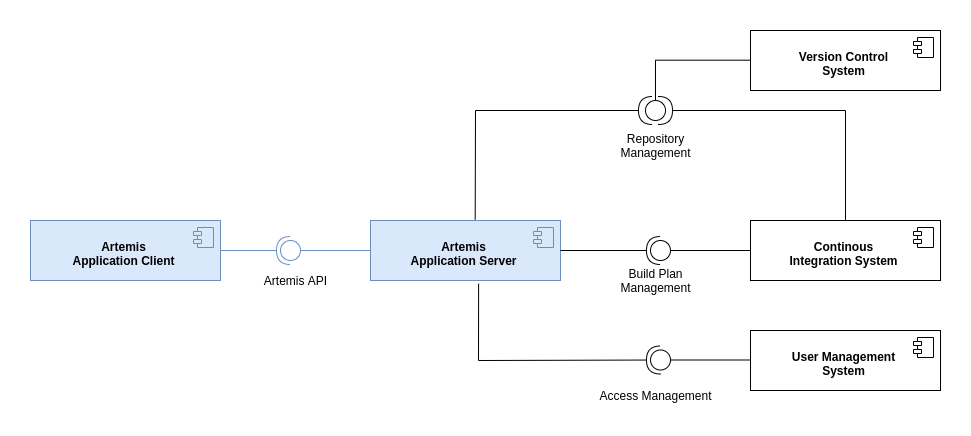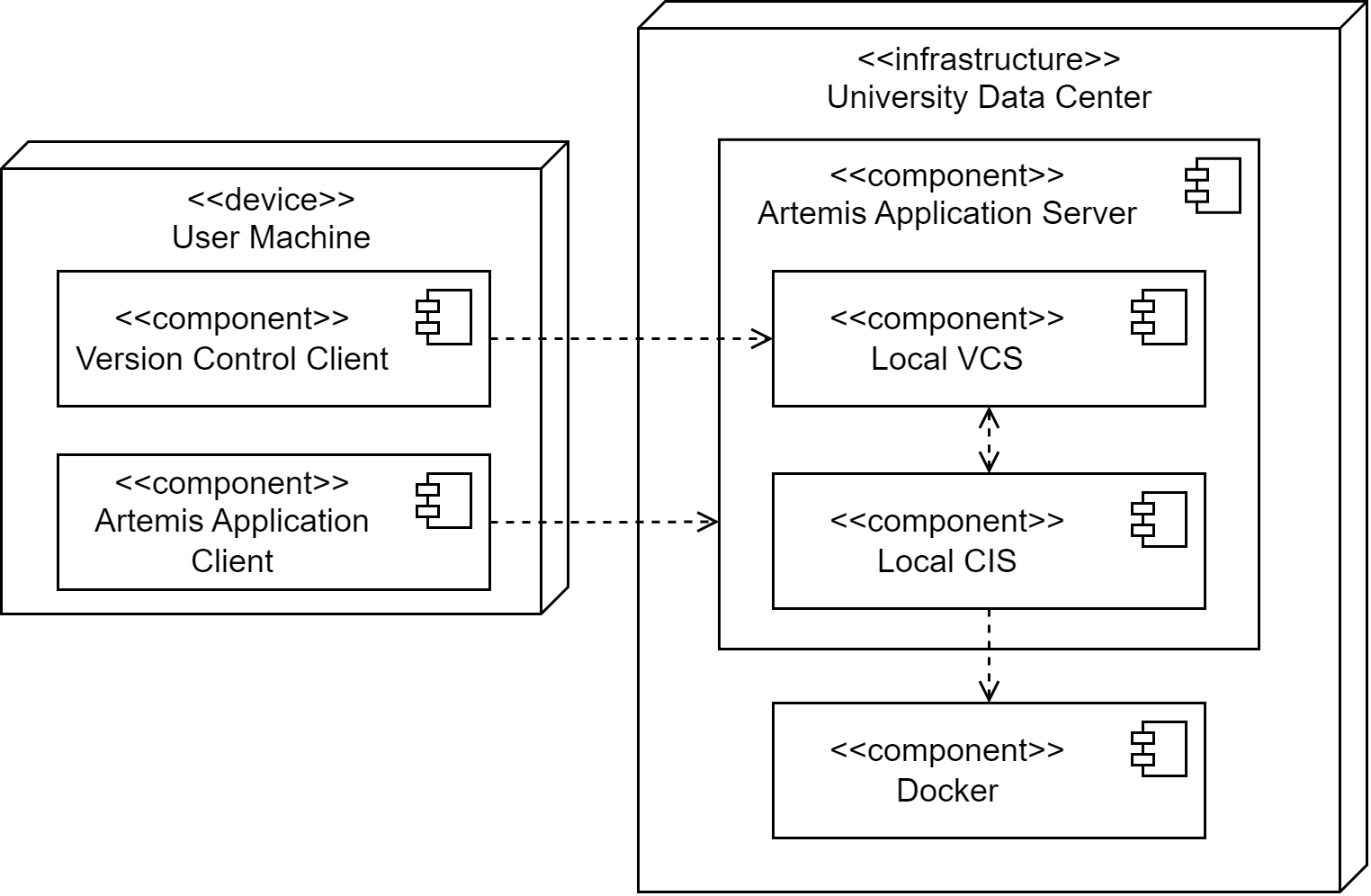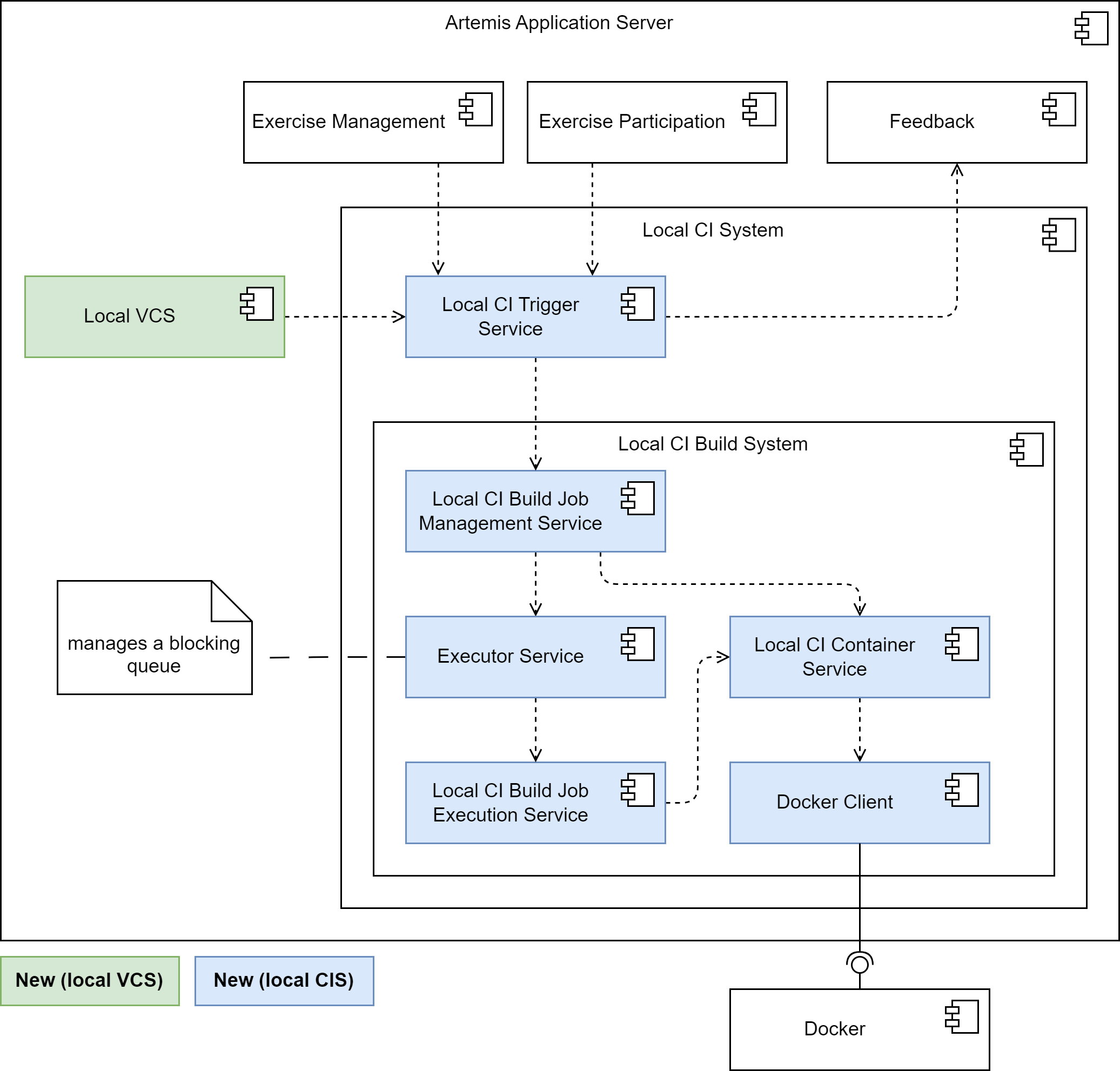System Design
Top-Level Design
The following diagram shows the top-level design of Artemis which is decomposed into an application client (running as Angular web app in the browser) and an application server (based on Spring Boot). For programming exercises, the application server connects to a version control system (VCS) and a continuous integration system (CIS). Authentication is handled by an external user management system (UMS).

Top-Level Design
While Artemis includes generic adapters to these three external systems with a defined protocol that can be instantiated to connect to any VCS, CIS or UMS, it also provides 3 concrete implementations for these adapters to connect to:
VCS: Atlassian Bitbucket Server
CIS: Atlassian Bamboo Server
UMS: Atlassian JIRA Server (more specifically Atlassian Crowd on the JIRA Server)
Deployment
The following UML deployment diagram shows a typical deployment of Artemis application server and application client. Student, Instructor and Teaching Assistant (TA) computers are all equipped equally with the Artemis application client being displayed in the browser.
The Continuous Integration Server typically delegates the build jobs to local build agents within the university infrastructure or to remote build agents, e.g. hosted in the Amazon Cloud (AWS).
Deployment Overview
Data Model
The Artemis application server uses the following (simplified) data model in the MySQL database. It supports multiple courses with multiple exercises. Each student in the participating student group can participate in the exercise by clicking the Start Exercise button. Then a repository and a build plan for the student (User) will be created and configured. The initialization state helps to track the progress of this complex operation and allows recovering from errors. A student can submit multiple solutions by committing and pushing the source code changes to a given example code into the version control system or using the user interface. The continuous integration server automatically tests each submission, and notifies the Artemis application server, when a new result exists. In addition, teaching assistants can assess student solutions and “manually” create results.
Data Model
Please note, that the actual database model is more complex. The UML class diagram above omits some details for readability (e.g. lectures, student questions, exercise details, static code analysis, quiz questions, exam sessions, submission subclasses, etc.)
Server Architecture
The following UML component diagram shows more details of the Artemis application server architecture and its REST interfaces to the application client.

Server Architecture
Integrated Code Lifecycle
Artemis supports an integrated version control system (VCS) and continuous integration system (CIS). If you use Integrated Code Lifecycle, the architecture differs from the architecture with external VC and CI systems. The deployment with Integrated Code Lifecycle (without using an external user management system) looks like this:

Integrated Code Lifecycle Deployment
Employing the Integrated Code Lifecycle, administrators and developers can set the Artemis application up without the need for dedicated VCS and CIS installations. This new architecture simplifies the setup process, reduces dependencies on external systems, and streamlines maintenance for both developers and administrators. Developers have fewer applications to run in parallel, which translates into decreased system requirements. See Integrated Code Lifecycle Setup on how to set the system up.
Hint
The system is still in an experimental state and not recommended for production. It currently only supports Java programming exercises built with Gradle and none of the advanced exercise configurations (like static code analysis).
Version Control Subsystem
The following diagram shows an overview of the components in the version control subsystem:

Version Control Subsystem
The Local VC Service implements the VersionControlService interface and thus contains methods that the exercise management subsystem and the exercise participation subsystem need to interact with the VC system.
E.g. the createRepository() method creates a repository on the file system.
For users to be able to access the repositories using their integrated Git client, the integrated VC subsystem contains a Git Server component.
It responds to fetch and push requests from Git clients, enabling instructors and students to interact with their repositories the way they are used to.
It encompasses all the logic for implementing the Git HTTP protocol server-side.
This includes extracting the command and parameters from the client request and executing the Git commands on the server-side repository, provided the repository exists, and the user has the requisite permissions.
It reads objects and refs from the repository, updates the repository for push requests, and formats the results of the Git commands it executes into a response that it sends back to the client.
This could involve sending objects and refs to the client in a packfile, or transmitting error messages.
The Git Server delegates all logic connected to Artemis to the Local VC Servlet Service.
This service resolves the repository from the file system depending on the repository URI. It also handles user authentication (only Basic Auth for now) and authorization.
For authorization (e.g. “is the requesting user the owner of the repository?”, “has the due date already passed?”), it uses the logic outsourced to the RepositoryAccessService that the existing online editor also uses.
For push requests, the Local VC Servlet Service calls the processNewProgrammingSubmission() method of the Programming Submission Service to create a new submission and finally calls the integrated CI subsystem to trigger a new build.
Integrating the VC system into the Artemis server application improves performance. For instance, when an instructor creates a new programming exercise, Artemis needs to copy the template source code to the template repository. Using the integrated VCS, Artemis merely needs to communicate with the host file system, copying the files from one location in the file system to another, which is faster than communicating with the external VCS through the network.
Continuous Integration Subsystem
The following diagram shows an overview of the components in the integrated continuous integration subsystem:

Continuous Integration Subsystem
The integrated CIS provides a concrete implementation of the ContinuousIntegrationTriggerService interface for the integrated CIS, the LocalCITriggerService, providing a triggerBuild method.
For instance, instructors can trigger builds for all student repositories from the Artemis user interface, when they changed the configuration of a programming exercise.
This may be the case after adapting the test cases for the exercise, rendering the build results of all students invalid.
Similarly, the student can manually trigger a build for their assignment repository from the Artemis user interface when there was an issue during the build process.
For each call to the triggerBuild method, the LocalCITriggerService delegates a new build job to the integrated CI build system.
We implemented the integrated CI build system in such a way that it restricts the amount of build jobs that can run concurrently and adds build jobs to a blocking queue in case it reaches the maximum amount of builds.
The integrated CI build system consists of four main services, that provide the task of managing a queue of build jobs, executing build jobs, and returning the build results.
The LocalCIBuildJobManagementService contains the logic for managing build jobs.
It prepares a build task in form of a lambda function and submits this task to the ExecutorService.
The ExecutorService encapsulates the low level logic for handling of the queue and the concurrency when running multiple build jobs at a time.
As soon as a build job finishes, the ExecutorService returns the result of the task execution to the LocalCIBuildJobManagementService.
The ExecutorService makes sure that errors happening during the build job execution are propagated to the LocalCIBuildJobManagementService, so it can handle all errors in one spot.
To improve the reliability of the system, the LocalCIBuildJobManagementService implements a timeout mechanism.
Administrators can configure a maximum amount of time that build jobs can run by setting the artemis.continuous-integration.timeout-seconds environment variable. The default value is 120 seconds.
If a build job times out, the LocalCIBuildJobManagementService interrupts the build job.
This is crucial to prevent jobs that require an abnormally high amount of time from clogging up the system and reducing overall system performance.
The LocalCIBuildJobExecutionService has the method runBuildJob, that contains the actual logic for executing a build job.
A basic build job for the purpose of providing automated assessment in Artemis consists of the following steps:
Start a Docker container for the build job.
Run the build script on the container. This involves:
Check out the repository under test (e.g. the student assignment repository) and the test repository containing the test cases.
Compile the source code of both the test repository and the repository under test.
Execute the test cases.
Retrieve the test results from the container.
Stop the container.
Parse the test results.
We designed the integrated CIS such that the process of scheduling and managing build jobs is decoupled from the process of actually running the builds and tests. Artemis only needs to create a new build job and add it to the queue. It does not need to know how or where the build job will be executed. This means that we can replace the mechanism for executing the build jobs without affecting the rest of the application, which allows us to outsource the tasks to external build agents in the future.
To address potential security risks associated with executing student code during automated assessment, we run the build job in a container, that the LocalCIContainerService creates and starts just for this purpose.
This container functions as an isolated environment.
If a student submits potentially malicious code, the container confines its execution, preventing it from directly affecting the host system or other containers.
The ephemeral nature of Docker containers allows the LocalCIBuildJobExecutionService to quickly remove them and the data they produced during the build when a build job finishes.
Finally, when the build ran through successfully, the integrated CI trigger service communicates the build result to the feedback subsystem, that makes it available to the instructor or student.
If there were any errors, the LocalCIBuildJobManagementService sends an error message to the Artemis user interface, that enables the instructor or student to take further action.
It also stops the container the build job runs in using the LocalCIContainerService.